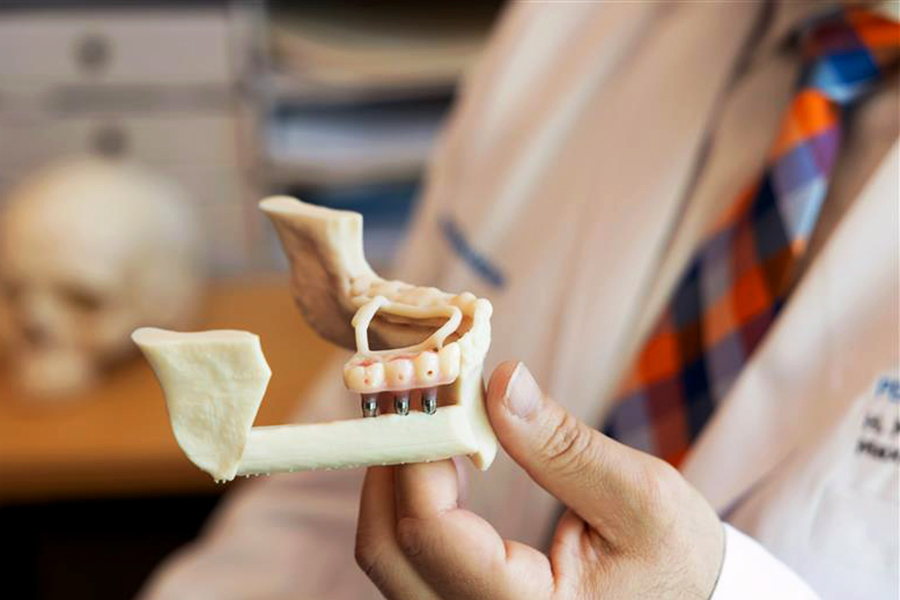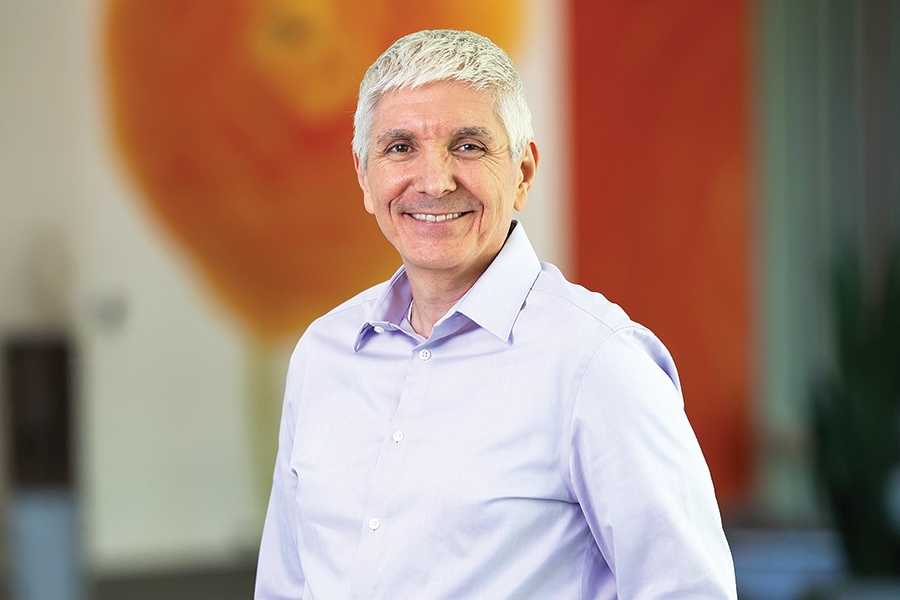A team of physicians specializing in minimally invasive gynecologic surgery in Kaiser Permanente Northern California are delivering the highest-quality care for patients, and shedding light on this complex, often-misunderstood condition.
December 20, 2024
Endometriosis is a significant public health issue that’s far more common than many people realize. The chronic inflammatory condition, caused by the growth of endometrial tissue outside the uterus, affects at least 1 in 10 reproductive-age women worldwide, or 6.5 million people in the United States alone.
The disease is complex and progressive, often resulting in scarring and tissue adhesions throughout the abdomen and pelvis. Symptoms can include heavy menstrual bleeding, dysmenorrhea, dyspareunia, chronic pelvic pain, gastrointestinal dysfunction, and urinary issues. Infertility is also common, affecting 30% to 50% of patients. The impact of the condition on daily activities, relationships, and physical and mental health can be severe.
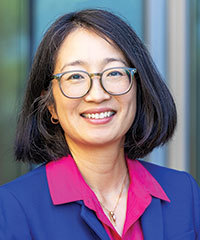
Miya Yamamoto, MD
Despite its prevalence and toll, endometriosis is under-diagnosed. On average, it takes four to 11 years for an individual to receive a correct diagnosis after symptom onset. Diagnosis is challenging for many reasons, among them that symptomatology and disease burden are not correlated, endometriosis lesions can be difficult to interpret or invisible on imaging, and symptoms can mimic those of other conditions, such as irritable bowel syndrome or fibroids. Some signs of disease can be overlooked entirely — including by patients themselves.
“If I could dispel one myth for patients, it would be the idea that severe menstrual pain is normal,” says Miya Yamamoto, MD, a minimally invasive gynecologic surgeon with The Permanente Medical Group (TPMG), who specializes in endometriosis and pelvic pain. “It is not normal — whether the cause is endometriosis, or something else.”
Comprehensive, integrated care
Dr. Yamamoto, who practices at Kaiser Permanente San Leandro, is the regional director of TPMG’s endometriosis program, which today comprises a team of 18 minimally invasive gynecologic surgeons with highly specialized expertise in the disease. She and her colleagues spearheaded the program in 2018 as a way to better coordinate the multidisciplinary care required for patients with endometriosis, and to create a stronger partnership between surgeons and pelvic pain specialists.
This team of surgeons, in collaboration with colleagues from pelvic pain, general ob-gyn, and reproductive endocrinology, developed an evidence-based care pathway that helps ensure that every patient with endometriosis sees one of our specialized surgeons for a prompt diagnosis and comprehensive, holistic care.
“Our surgeons work with patients to develop a treatment plan that’s tailored to their individual needs and goals, and outlines how we’re going to manage the disease together over the long term,” says Dr. Yamamoto. “In addition to surgical and medical management, this may involve working with pelvic pain and fertility specialists, as well as pelvic floor physical therapists and pain psychologists.”

Kari Carlson, MD
To further support patients, Dr. Yamamoto led the development of a specialty care website on My Doctor Online that provides education on the condition and treatment options, and highlights our team of experts.
“The endometriosis program exemplifies the best of Permanente Medicine,” says Kari Carlson, MD, TPMG associate executive director and an ob-gyn physician. “We are providing a continuum of comprehensive, integrated care that begins with the established relationship a patient has with their primary ob-gyn and connects to our specialists and ancillary support services — all within the same system. The result is exceptional end-to-end care.”
The early years — growing surgical expertise
Over a decade before our endometriosis program was formally established, a handful of gynecologic surgeons, including Eve Zaritsky, MD, and Jaime Ocampo, MD, were laying the groundwork. They joined TPMG in 2006 and 2007, respectively, after completing subspecialty training in minimally invasive gynecologic surgery (MIGS), at a time when the surgical management of gynecologic conditions — including endometriosis — was undergoing significant advancements.
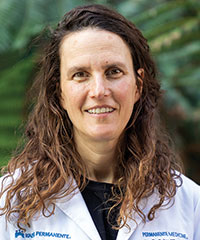
Eve Zaritsky, MD
One of these was a shift from open surgery to minimally invasive surgery. To help usher in this change within TPMG, Drs. Zaritsky, Ocampo, and a few others launched an effort to share their expertise with colleagues, and from 2007 to 2010 they trained gynecologic surgeons at medical centers throughout KP Northern California to use minimally invasive techniques for common surgeries like hysterectomies.
“Within four years, we took hysterectomies for non-malignant conditions like endometriosis from a rate of about 80 percent open surgery to 80 percent minimally invasive surgery in KP Northern California,” says Dr. Zaritsky, who coauthored a study about this initiative in the Journal of Minimally Invasive Gynecology in 2019. “Today, our rate of minimally invasive benign hysterectomy is 98 percent, compared to the national average of 76 percent, and we have no racial disparities in the types of surgeries people receive.”
Extirpative procedures like hysterectomy and oophorectomy are sometimes part of surgical treatment for endometriosis, but to preserve fertility and avoid early menopause in younger patients, surgeons usually recommend removal of endometriosis lesions via excision and preserve the reproductive organs when possible.
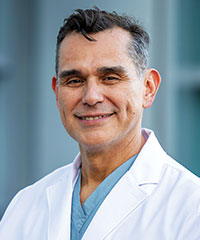
Jaime Ocampo, MD
Excision is extraordinarily complex, as it can involve the dissection and removal of abnormal tissues dispersed throughout the pelvis, “similar to cancer surgery,” says Dr. Ocampo.
“In severe stages of endometriosis, patients experience deep infiltration of endometriotic tissue into normal tissue,” he continues. “It can invade not only the reproductive organs, but also gastrointestinal and urinary organs, and rarely even the diaphragm and lungs. Excision may require cutting areas along the intestines and ureters, for example, which adds risk and requires additional training and skill.”
TPMG’s roster of minimally invasive gynecologic surgeons able to conduct this complex surgery continued to grow over the decade after Drs. Zaritsky and Ocampo joined the organization. At the time the endometriosis program was launched, the medical group had seven physicians with MIGS expertise. Today, this number has more than doubled, and more than 95% of all benign gynecologic surgeries performed in TPMG are minimally invasive.
Managing chronic pelvic pain
Also essential to exceptional endometriosis care is the management of symptoms, the most challenging of which is chronic pelvic pain. Defined as six months or more of non-menstrual pain, pelvic pain does not have to be constant to be considered chronic. It is experienced by about a third of patients with endometriosis, and it may flare cyclically, such as during menstruation, or only occur at certain times, such as during sexual activity. It can be difficult to determine how much of a patient’s chronic pain symptoms are related to endometriosis versus other organ systems.
Every service area in Kaiser Permanente Northern California has one or more physicians who are trained to evaluate and treat pelvic pain. Some endometriosis surgeons in TPMG, including Dr. Yamamoto, also specialize in pelvic pain. At their medical centers, patients with both concerns see one practitioner. In other medical centers, like Dr. Zaritsky’s, the specialties are separate, and physicians collaborate for optimal care.
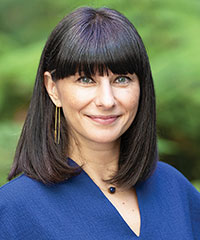
Erika Deraleau, MD
“For a patient with endometriosis and chronic pelvic pain, having access to skilled surgeons is extremely important,” says Erika Deraleau, MD, regional co-lead for chronic pelvic pain and vulvovaginal disorders, who partners with Dr. Zaritsky at Kaiser Permanente Oakland. “But because endometriosis is a neuroinflammatory pain condition, removing the endometriosis lesions surgically doesn’t necessarily solve the entire problem. For patients to have the best outcome and improvement in their pain, we need to take a step back and look at them more holistically, because other treatment modalities likely will help long-term.”
The key to this holistic approach, Dr. Deraleau explains, is uncovering all the pain generators.
“Any structure in the anatomic pelvis can lead to pain,” she says. “With endometriosis, we often think of the ovaries and uterus. But we also have to think about the bowel, urinary tract, and muscles and fascia of the pelvis. Our central nervous system is also involved in pain signaling, so we have to consider the peripheral nerves, spinal cord, and brain. And with chronic pain, changes happen in the central nervous system that affect how a patient experiences pain. Chronic pain also increases the risk of depression, anxiety, and other mood disorders, and having a concurrent mood disorder often makes pain worse at a biochemical level.”
Myofascial pain is one of the most common causes of chronic pelvic pain for patients with endometriosis, often resulting from years of contraction of the musculature in the pelvic floor in response to severe menstrual pain, or from conditions like irritable bowel syndrome, which often accompanies endometriosis.
“Patients can develop reactive myofascial areas that will spasm at any moment — with movement, sex, or bowel movements, for example,” Dr. Deraleau says.
A collaborative care pathway
The first step in helping women with endometriosis, who may or may not also have chronic pelvic pain, is a diagnostic assessment by the patient’s primary ob-gyn physician, who may order pelvic imaging studies and laboratory tests, as appropriate.
Patients can be referred for evaluation by endometriosis surgeons when certain findings occur, such as positive imaging showing an endometrioma, which is an ovarian cyst filled with endometrial tissue, or persistent hemorrhagic cysts. Referrals to endometriosis specialists can also be made for patients with more unusual presentations, such as endometriosis found on colonoscopy, or in the umbilicus.
Patients with negative pelvic imaging and chronic pelvic pain that doesn’t respond to first-line treatment by their ob-gyn, however, are referred to a pelvic pain specialist first, before seeing an endometriosis surgeon.
“The historical teaching in gynecology residency training was that if patients have pelvic pain, they probably have endo-metriosis and should have surgery,” Dr. Yamamoto says. “However, there is now significant evidence that when you do laparoscopy on a patient with chronic pelvic pain and normal imaging, you find normal pelvic anatomy 40 percent of the time.”
She explains that this is because in 80% of cases, the origin of chronic pelvic pain is non-gynecologic.
“Surgery is not without risks and complications, and if there is no benefit for most patients, we should not recommend it routinely,” she continues. “In TPMG, we do a full 360- degree evaluation first to find all possible sources of pain and treat them, while also considering surgery.”
Building a multimodal treatment plan
Once a diagnosis of endometriosis has been made, TPMG specialists work closely with patients to develop a management plan that’s tailored to their needs.
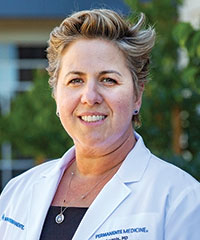
Anna Lyapis, MD
“You cannot do cookie cutter management for this disease — no two patients are alike,” says Anna Lyapis, MD, minimally invasive gynecologic surgeon at Kaiser Permanente Union City.
“The key is to listen to patients’ symptoms and concerns, as well as understand their family planning goals and where they are in life.”
Medical management with hormone therapy is part of treatment for most patients, as it’s critical to preventing lesions and controlling their growth. For some patients, hormone therapy is sufficient to allay symptoms.
“We consider surgical management when a patient is having a significant amount of pain, and we see masses and have a clear sense of what we can resect,” Dr. Lyapis says. “But if patients still have their ovaries, the endometriosis can grow back. We have to stay on top of it to prevent flares or recurrences, so that surgery doesn’t become a repetitive treatment. Repeat surgeries have a greater chance of surgical complications.”
During surgery, endometriosis surgeons look everywhere in the pelvis for signs of disease, and they discuss with patients beforehand about preferences on how to proceed based on what they find. Endometriosis surgeons can also bring in experts from other surgical disciplines. If they find mid-surgery that an appendectomy is needed, for instance, they call in a general surgeon.
“In more complex situations, we know in advance which types of surgeons we need to involve, and we plan the surgery together,” says Dr. Yamamoto. “For example, for a patient who had endometriosis biopsied in the rectum during a colonoscopy, we would partner with a colorectal surgeon to possibly do resection of the colon while we do the pelvic endometriosis surgery. With diaphragmatic lung endometriosis, we would work with thoracic surgery. We also do combined surgery with urologists, because endometriosis lesions can grow into the ureters and block them, as well as grow into the bladder.”
Fertility strategies
For patients who are struggling with infertility or want children in the future, endometriosis specialists add fertility strategies to the treatment plan.
“Having endometriosis decreases the chance of successful pregnancy per menstrual cycle quite dramatically,” says Dr. Lyapis, adding that this is true even in the absence of ovarian cysts, for reasons that are not well understood. “When cysts are present, they may impact successful stimulation of the ovary for infertility treatment. But if we remove the cysts, we have to incise into the ovary and suture it back together, which decreases ovarian reserve.”
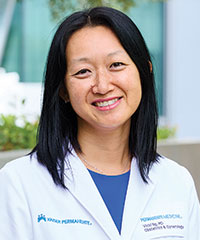
Vicki Ng, MD
“It’s a fine balance to determine what makes the most sense for the patient,” says Vicki Ng, MD, a minimally invasive gynecologic surgeon at Kaiser Permanente San Francisco. “Surgery can help some endometriosis patients be more fertile, but studies show that doing infertility treatment right away leads to a greater chance of success versus surgery alone.”
This is why for infertile patients with a small endometrioma, surgery may not be the appropriate first step, even if a patient is having pain.
“We would advise these patients to see one of our reproductive endocrinologists first, and depending on their age, counsel them about the odds of getting pregnant with their own eggs,” Dr. Lyapis says. “If they’re eligible to do in vitro fertilization [IVF] to bank some embryos, we can do staged surgery, in which we can pause the IVF cycle between the retrieval and transfer of the embryo to do some surgical management.”
For patients with a large mass or extensive disease, the calculus changes. “For them, we recommend surgery first,” Dr. Yamamoto says. “During surgery we’ll also check the fallopian tubes because they can be blocked with disease or scar tissue. We discuss with patients in advance if they would like us to remove a damaged tube, because if the patient needs IVF in the future and has a dilated, blocked tube, this can reduce implantation by up to 50 percent. We talk through all the potential scenarios with our patients and look at their care long-term — whenever possible, we want to spare them a second surgery down the line.”
Getting pain under control
The final piece of the puzzle is treating pain. TPMG pelvic pain and endometriosis specialists work with patients throughout the care journey to help get it under control.
“For pelvic pain that is myofascial or neuropathic, we refer patients to pelvic floor physical therapy, offer medications to help treat chronic pain, and sometimes do procedures like pelvic floor Botox injections or a nerve block,” says Dr. Deraleau. “If patients have irritable bowel syndrome or urinary dysfunction, we help treat that as well.”
“We also make sure to recognize any trauma a patient may have experienced and offer appropriate referrals for support,” adds Dr. Yamamoto. “Pain, stress, and anxiety affect overlapping areas in the brain, which impacts healing if unaddressed.
“Our overall goal is to reduce a patient’s pain flares and daily pain levels,” she continues. “We are realistic with patients that they may never be completely pain free, but we can help get them to a place where pain is no longer controlling their daily quality of life.”
TPMG pelvic physical therapists focus on pelvic floor muscle relaxation and stretching exercises, patient education, and behavioral modifications. They also use technology to help patients track their progress. One example is a mechanical biofeedback device that enables patients to see what their pelvic floor muscles are doing in real time.
Dr. Deraleau explains that some patients may benefit from seeing one of our pain psychologists, as well, to better manage the thoughts, feelings, and behaviors related to chronic pain.
“Pain psychologists have specialized training to help decrease the experience and impact of pain in patients’ lives, and they use evidence-based strategies to help patients cope,” she says. “This might be through addressing maladaptive pain behaviors, for example, or helping patients calm an amped-up sympathetic nervous system, which can impact the pain response.”
Spreading the word
To help spread the word about the deep bench of endometriosis and pelvic pain expertise within TPMG, Drs. Lyapis, Yamamoto, and Zaritsky led the effort to develop our patient-facing web content. They and their colleagues also led informational sessions at every medical center for fellow clinicians.
Dr. Zaritsky is helping amplify the work further. She conducted soon-to-be-published research with the Kaiser Permanente Division of Research that examines equity in care for endometriosis and pelvic pain disorders in Kaiser Permanente Northern California. She measured whether racial disparities exist in diagnosis and medical and surgical management patterns within our integrated system.
“Nationally, Black women and people of color tend to get short shrift in care related to pain and endometriosis surgery,” says Dr. Zaritsky. “Compared to white patients, for example, they get less pain control, are more likely to lose an ovary, and have open surgery at higher rates. But within Kaiser Permanente Northern California, we did not find this.”
In their study of patients between 2012 and 2019, they found no racial variations in surgical management and rates of laparoscopic surgery, and Black women received slightly more hormonal and pain management than other races. An abstract about the research was published in the American Journal of Obstetrics and Gynecology earlier this year, and Dr. Zaritsky expects to publish their full findings in 2025.
“Dr. Zaritsky has shown that when endometriosis and pelvic pain specialists follow an algorithmic clinical pathway in a multidisciplinary, integrated environment, we provide better care and reduce inequities that might have been created by unconscious bias,” says Dr. Carlson. “I couldn’t be prouder of this incredible team of TPMG physicians, the program they built, and the outstanding care they help us provide to our patients.”
This article originally appeared in Permanente Excellence, the magazine for physicians in The Permanente Medical Group.



